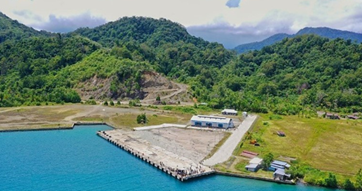Performance Analysis of Depapre Port as a Sea Toll Node in Supporting Logistics Distribution in Jayapura Regency
Main Article Content
Abstract
A port is said to have a good level of service if the time required for loading and unloading activities is shorter than the specified schedule. In order to smooth the flow of goods, increase the effectiveness of port operational performance, it is necessary to use service performance standards as a benchmark to determine the level of service that can be provided to service users. Depapre Port is one of the ports that plays an important role in the process of progressing economic growth in Papua Province. The availability of facilities and infrastructure at Depapre Port greatly influences the smooth distribution of logistics in the Papua Province region, specifically in areas on the T-19 Route, namely Merauke – Kokas – Sorong – Biak/Korido – Depapre/Jayapura – Sorong – Merauke. Port performance is analyzed using the Decree of the Director General of Sea Transportation Number HK.103/2/18/DJPL-16. This research will discuss the performance of Depapre Port in distributing logistics in the Jayapura Regency area. In addition, this study also identified the factors that influence the performance of Depapre Port by conducting interviews and direct observation of several informants who understand and are involved in port activities, which are divided into 5 categories: Humans, Ship Service Facilities, Environment, Material and Methods and will explained in more depth using cause and effect diagrams. The results of this study will then be evaluated so that an improvement effort can be determined so that the performance of the Depapre port can run normally like other ports in Indonesia.
Downloads
Article Details

This work is licensed under a Creative Commons Attribution 4.0 International License.
Allow anyone to modify, improve, and make derivative works, even for commercial purposes, as long as they credit to you for the original work.
References
M. T. Azikin, A. S. Sukri, Andriyani, and Ikhwan Amulana Hatta, “Analisis Kinerja Pelabuhan Bungkutoko Kendari Terhadap Tingkat Penggunaan Lapangan Penumpukan (YOR),” Stabilita, vol. 7, no. 3, hlm. 269, Nov 2019.
Kementerian Perhubungan, Keputusan Menteri Perhubungan Republik Indonesia Nomor KP 927 Tahun 2017 Tentang Rencana Induk Pelabuhan Depapre Provinsi Papua. Indonesia, 2017.
P. Damongilala, A. Sutrisno, and J. Mende, “Pengukuran Kinerja Operasi Bongkar Muat Petikemas di Pelabuhan Bitung, “Jurnal Tekno Mesin Unsrat, vol. 8, no. 1, hlm. 5, sJuni 2022.
P. Katias, I. Kharisma, and K. Muhammad, ”Analisis Kinerja Berth Time Kapal Kargo Muatan Curah Kering dan Usulan Perbaikannya di Terminal Jamrud Pelabuhan Tanjung Perak Surabaya,” Business and Finance Journal, vol 2, no. 2, Okt 2017.
D. H. Munah, I. W. Suteja, and I. G. P. Warka, “Analisis Pengukuran Kinerja Pelabuhan Laut Lembar Berdasarkan Kriteria Kinerja Pelabuhan, “Gara, vol. 12, no. 1, Mar 2018.
M. A. L. Pambudi and T. Handayani, “Application of Sea Toll as a Means to Maintain the Availability of Goods in the 3T Area (Lagging, Frontier and Outermost)”, mp, pp. 8-16, Jun. 2023.
Indonesia.Go.Id Portal Informasi Indonesia, “Pelabuhan Depapre Disiapkan sebagai Hub Indonesia Timur,” 2022. https://www.indonesia.go.id/kategori/editorial/3905/pelabuhan-depapre-disiapkan-sebagai-hub-indonesia-timur

